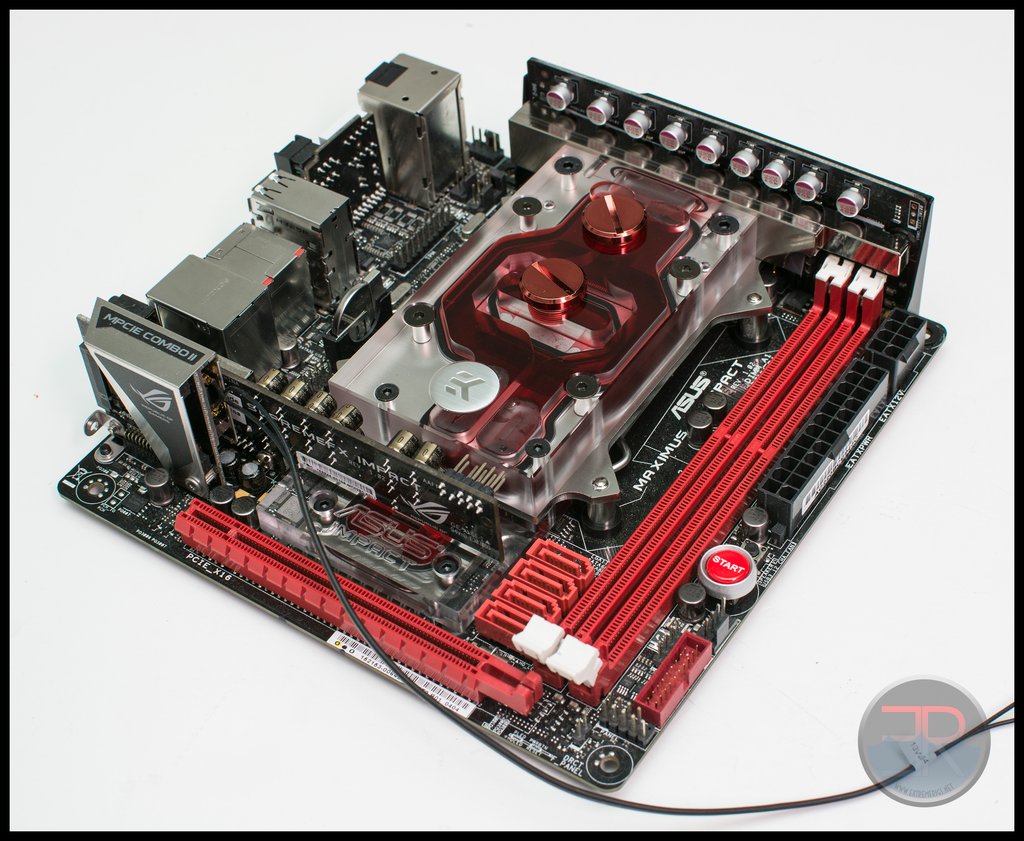Thermal testing was done under a synthetic CPU load (prime95 with custom settings). The coolant was allowed to warm up for 40 minutes and then 20 minutes of data was logged. Thermal data from Dallas “one wire” digital probes logged coolant and ambient temperatures while HWInfo and RealTemp were used to probe motherboard and CPU temperatures respectively. Due to Haswell’s poor thermal connection between die and IHS the CPU was over clocked at a measly 4.2GHz as anything larger would lead to thermal throttling. Additionally VRM daughterboard temps were measured at single points in time using an infra-red “laser” thermometer. MX2 TIM was used instead of the supplied TIM in order to only analyze block performance on it’s own. Only one flow rate was used and the pump (an MCP35x2) was set to a PWM setting that closely resembles the flow of a D5 at setting 4 and gave flow rates in the 1.3-1.4GPM range depending on the block.
The first thing to analyze is the CPU core temperatures. EK told me that the block should outperform the EK Supremacy. I expected that it would, but having seen that the Koolance CPU-380i still beats the Supremacy on a 4770K I assumed that the CPU-380i would also outperform the impact.
The differences are small if we look at the big picture:
However if we zoom in we can see that the Impact block performs excellently and has a 1C lead over the CPU-380:
Of course the Impact not only cools the CPU but it also cools the VRM and south bridge. As many of you know Haswell is so low power and has integrated so much into the CPU now that VRMs and south bridges really don’t need to be water cooled anymore. If we look at the south bridge first we see that the Asus air cooler gives very acceptable temperature deltas:
We also see that when water cooled the temperature delta is basically 0. Of course bear in mind that this is a delta to ambient and of course the coolant to ambient delta is about 3C. So we know that the temperature sensor therefore can’t be that well calibrated because otherwise the SB to coolant delta would be negative which would be impossible unless the south bridge was cooling the coolant.
This explains the next plot:
The actual VRM delta measured was 0.03 degrees. Again because the VRM sensor is not well calibrated we know that there is some small (but larger than 0 temperature difference). Still this is impressive. The fact that the cooling is so good that the temperature delta is within the calibration error of the part’s temperature sensor is extremely good. Just to confirm all of this I manually took some temperatures on the PCB of the VRM duaghterboard. I searched out the hottest spots and compared to ambient temperatures:
Again we see a roughly 20 degree drop between the air cooling and EK’s impact block. Bear in mind on this test that Asus would probably do better if they put a thermal pad on their chokes.
On to the summary!

















I would love a Maximus Gene VI version of this. The southbridge might be cooled without the inlets and outlets blocking the second PCIE 3.0 slot. But mostly it would just look bad ass.
[…] you’re focussed on every last degree you might want to wait for EK’s monoblock. In our Impact testing we saw that the monoblock performed better thermally as well as being lower restriction than a […]
[…] we’ve had a new CPU block up for test. The last mini cpu block testing we did was on the Impact Monoblock. For this review we will still be testing on the 4770K/Max VI Impact combo, but at a different […]
Most consumers will be considering Monoblock (based on the previous Supremacy) vs the Supremacy EVO, comparison of Delta T vs Supremacy EVO would make an interesting comparison also. It would also be interested to know the pressure drop of this monoblock compared to CPU only solutions.
I think these would be relevant given that Z97 chipset and Power MOSFET passive temperatures don’t seem excessive.
Anyways, thank you. Appreciate the review.
Comments are closed.